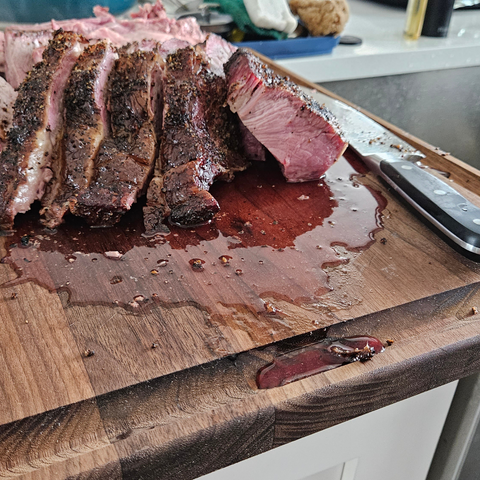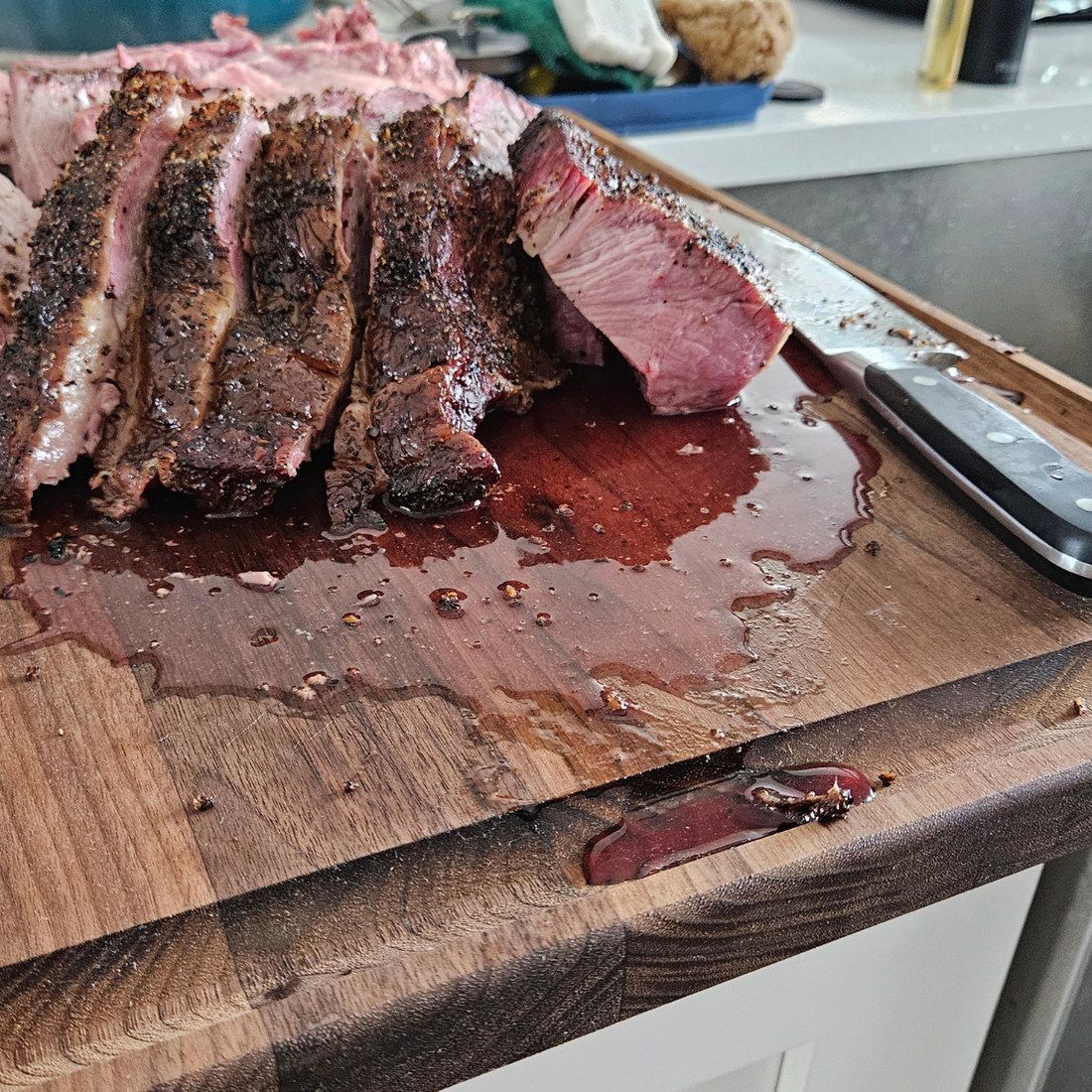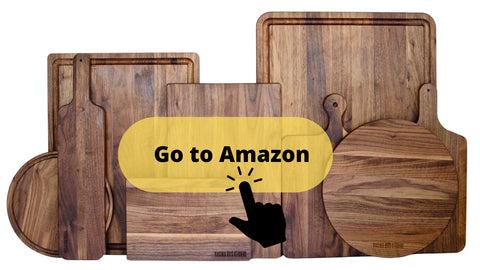Owning one cutting board in your kitchen might seem like the best idea. Until you realize you need different wooden cutting boards for different tasks. I mean, you probably won’t want to use the same size cutting board to cut veggies as you do to slice up a delicious brisket!
This is why building your collection of wooden cutting boards over the years is so important. Today, we are going to be sharing the best cutting board for brisket. So, if you don’t have a brisket cutting board just yet, you will know which one to buy at the end.
What to Consider When Purchasing a Cutting Board for Brisket
In a nutshell, the things you need to consider are when looking for the best cutting board for brisket, are the following:
- Size
- Material
- Non-slip surface
- Juice groove (AKA drip groove, juice well, or juice channel)
1. Size
You'll want a cutting board that is large enough to accommodate the size of your brisket. A larger cutting board will give you more room to work, making it easier to prep the brisket.
You need enough room to trim the fat, and enough room to season the brisket to prepare it to be smoked, bbq'd, or put in the oven.
Hint: you didn't know you're suppose to trim a brisket before cooking it? Read our full guide on how to trim a brisket. Alternatively, you can buy one that's already trimmed. This is not common for large briskets 8lbs or more, but you can find smaller 4-6 pound pieces with the fat already trimmed.
To determine the best size for your cutting board, you have to first decide what size brisket would you normally cook? Briskets can be as large as 15 pounds, and can be as small as a 3-lb piece from the butchery. A full sized piece is around 15 pounds, and a half piece is around 8 lbs - they are still quite large.
This image below shows a half piece that weighs 8lbs:

When it comes to size of the cutting board, the bigger the better. At the very least, you'll need a sturdy board that is at least twice the size of your brisket. This will give you plenty of room when you are trimming your brisket and season it for bbq, smoke, or the oven.
2. Material
Cutting boards come in a variety of materials, including glass, slate, wood, plastic, and composite materials.
Wood cutting boards are durable and can be treated with oils to help prevent bacteria growth. They can also be waxed, to add an additional layer of protection - and also makes it easier to clean. Food will literally slide right off your board without a fuss. Plus, it looks all shiny and nice, like this one:
Plastic cutting boards are lightweight and easy to clean, but they can dull your knives over time, and if they have dents in them, that's an invitation for bacteria to come live.
Composite cutting boards, or boards made from bamboo, might seem like a good middle ground for most people. However these materials aren't as durable as wood - and they can't be renewed. Once they show knife marks or deep cuts there's nothing much you can do. On the contrary, wood can be sanded, renewed, oiled, and restored over and over again.
Let's briefly go over some common cutting board materials when compared to wood.
Wood Vs Plastic:

If there is a deep scratch or a nick in your plastic board, it becomes a great hiding place for bacteria.
Over time deep knife marks on a plastic board become worn out, it cannot be repaired like a wood board can.
Most plastic cutting boards are also thin and slides around your kitchen table - not the best surface to handle something as large as a brisket.
Wood Vs Bamboo:
Although it is an inexpensive option, bamboo is actually a grass, not a wood. Although bamboo cutting boards are wonderful for food preparation and serve as great cutting surfaces, they are not as sturdy as wooden cutting boards.
Bamboo cannot be polished, repaired, or refinished after it develops wear indicators like knife scratches and stains. With wood, it can be made new again even after a generation of use.
Bamboo also does not natively grow in the United States so if you're buying a bamboo board, it is most likely made in China.
I don't know about you, but buying a food surface item from China doesn't sound very appealing to me.
At Virginia Boys Kitchens, we only use wood grown in America, and all of our items are made in USA, including packaging and shipping materials. See our mission here.
Wood Vs. Glass, Marble, or Slate

Do you hear the clanking noises when you use your expensive knife on a glass, marble, or slate surface? It will literally dull out your knife very quickly.
They might be fine to slice cheese on, but definitely not to be used as a surface that's meant to be chopped on.
They also tend to come in small sizes only. They break so easily that these boards are more suitable for display, rather than to be used.
They do make a great looking cheese board for 2 people! You won't find a marble, glass, or slate piece big enough for your brisket.
Other properties for a good brisket board:
3. Non-Slip Edges
Non-slip edges are definitely helpful, but if your board is very large to accommodate a large brisket, chances are, you wouldn't have to worry about this issue.
Typically when you buy a board that is larger than around 24 inches or so, chances are it's also so heavy that it won't be slipping.
But rubber feet are definitely awesome to have, provided the board you're buying is so thick that the chances of it warping is very low!
You'll know a board is thick enough when you see one, like this 20x16 end grain one here:
Some people prefer working with a wood board that also has rubber feet - this is an excellent choice if you are buying a board that is at least 1.5" thick, so the chance of it warping is low.
Typically, when a cutting board is 1-inch or thinner, you don't want rubber feet because then you'll end up only being able to use one side of the board - this may contribute to future board warping.
For a board this thin, you'll want the board to be reversible so that you use both sides, wash both sides, and oil both sides. This keeps it in tip top shape and prevents board warping (see our collection of reversible boards here).
4. Juice Groove
A cutting board for brisket should have a juice groove - it helps catch the juice when you carve into it. A typical extra large board such as our 18x24x1 inch extra large board holds 1oz of juice (that's plenty for the juices that come from a brisket).
It's also helpful to have this ridge when you are seasoning the brisket - the extra seasoning rolls and stay put in the ridge, instead of on your kitchen table.
Obviously this isn’t a necessity, but it sure makes it easier and faster to clean up once you're done seasoning or carving your brisket.
If you're not a huge fan of the juice groove, no worries - most boards that have a juice groove won't have it on both sides. Just use the other side instead.
CONCLUSION: Best Cutting Board for Brisket

The best cutting board for brisket is a wooden butcher block that is larger than your brisket. This 18 x 24 inch Walnut Wood Cutting Board is a perfect choice for brisket.
You have plenty of surface working area - trim the fat, season the brisket, prepare it for smoking, etc...
This wooden cutting board is one inch thick, is reversible, has a nice deep juice groove, and is made from sustainable walnut wood.
This makes the board quite sturdy, safe for raw meat, and enough room for the entire brisket-making process.
The juice groove on this board is deeper than a lot of similar sized boards you might be on the marketplace. It holds a total of 1oz of juice (that's plenty for a brisket).
This ensures all the juices are contained on the board and not on your kitchen table, like below:

This is a also reversible cutting board. You can easily one side for carving and cutting and the other side (without the juice groove) for serving.
While this wooden cutting board is perfect for brisket, you will also be able to use it for many other kitchen tasks.
Imagine carving a 20 pound turkey, slicing a monster watermelon, or cutting up a huge rack of ribs. The walnut used on this board is easy on knives, so your knives won’t get dull after just a few uses.
What if my brisket is larger than 8lbs?
You probably need a larger board. However, we're now in the territory of a very large cutting board that might not fit your kitchen, or a board that is literally used just for this brisket and nothing else.
A board that is 18x24 is pretty large - it might not (comfortably) fit a lot of kitchen cabinets, and is already difficult (but possible) to clean in your kitchen sink. Anything larger might be tricky.
It will certainly be a better working surface for your brisket if you've got a pieces a lot larger than an 8lb piece, but you may not be able to use it for anything else.
At Virginia Boys Kitchens, we don't have any boards larger than 18x24 inches, so if you're intent on buying a very large board, we recommend you still adhere to the following guidelines:
- Choose walnut, maple, or cherry (see full article that explains why here)
- Choose made in USA whenever possible - imported woods are fumigated, and bamboo is a grass, not a wood!
- Choose a board at least 1-inch thick. 1.5 inches is even better
- Be mindful of where you'll keep the board, and how you'll wash it in your kitchen! (is your kitchen or sink large enough? Might you need the hose?!)
Conclusion
A good ole piece of American BBQ'd or smoked brisket deserves a good ole piece of wooden cutting board - just the way Pops and grandma would do.
Related Articles You Might Like:
Cooking Bacon in Stainless Steel Pans
Best Wood For Cutting Boards (and what not to use)
Related Products You Might Like:
Our largest board, the 18x24x1 inch

Our next thickest board, with rubber feet, measures 20x16x2 inches:

See Virginia Boys Kitchens On Amazon
We are on Amazon, see our storefront here. Use coupon code VBKBLOG10 for 10% off your entire purchase of any Virginia Boys Kitchens on Amazon. Apply the code at checkout.





